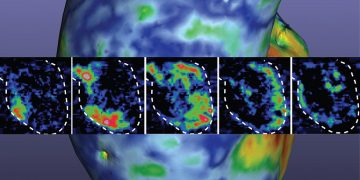About a week after Steven Mikac began taking antibiotics for the strange spot on his leg, the flesh around his ankle started to tighten and swell. The moist orifice of a wound opened up and took the form of a small bullet hole. A plug of tissue had gone missing—dissolved into pus and slime. Walking was excruciating. Working, unbearable. In early October of last year, Mikac showed his ankle to a colleague at the hospital where he works in Melbourne, in the Australian state of Victoria. She suggested that it might be Buruli ulcer—a disease caused by a strain of flesh-eating bacteria.
Though Mikac had seen local television reports about an outbreak of this tropical disease in Victoria, it sounded so freakish, so unlikely, that he hardly considered it a possibility. But like hundreds of Australians before him, he was about to become all too familiar with Buruli, a slow-moving horror show that has proved, in many ways, even more baffling to infectious-disease researchers than the novel coronavirus. After decades of research, scientists still aren’t certain who, or what, is spreading this strange malady around the world.
In late October, Mikac met me inside the infectious-disease ward at the hospital where he works and is now a patient. He is a soft-spoken man of 54 with the body of an aging rugby player. He was dressed in shorts and flip-flops. A bandage had been slapped on his left ankle. “It was just a little spot, but I felt there was something different about it,” he said.
We were soon called into an exam room where Mikac’s white-haired, bespectacled doctor, Paul Johnson, greeted us. Johnson has been studying Buruli cases in Australia for decades, and he sees every new case as a chance to crack the disease’s enigma. A few weeks earlier, Mikac had divulged to Johnson one telling clue. His parents own a beach house in the town of Rye, on the Mornington Peninsula south of Melbourne. He had recently helped them out by doing brushwork on the property, and had likely returned to the city with the usual scratches and mosquito bites.
Johnson’s ears had perked up at that. Mikac had been inside a Buruli hot spot, a place where caseloads were far higher than in surrounding areas, and Mikac had been doing the kinds of outdoor activities that notch up a person’s risk. Johnson confirmed Mikac’s diagnosis with a DNA test. The process is more traumatic than one might expect: He had to plunge a cotton swab into the maw of Mikac’s open wound and scrape out the gunk inside as Mikac cringed in pain. Johnson put Mikac on two powerful antibiotics, clarithromycin and rifampicin, which turned Mikac’s urine the color of orange Fanta.
Two weeks into the eight-week course of antibiotics, Johnson was now checking on Mikac, his fourth Buruli case of the day. Mikac lay on his side on the exam table as a nurse removed the bandage. “Do you feel like it’s getting worse, better, or the same?” Johnson asked him.
“Worse,” Mikac groaned.
“What you’ve got—the infection is that big,” Johnson said as he sketched a circle around the wound, like the flanks of a small volcano. “But it’s going to get bigger.” He warned Mikac that the antibiotics had shut down Buruli’s defenses, and now the body would launch an attack on the infected tissue. The pus was building up under the skin, and it was about to blow. “Once it breaks through,” he said, “it will feel a lot better.”
Buruli gets its name from a former county in Uganda on the western bank of the Victoria Nile, which emerges from Lake Victoria and flows north toward Sudan. Apart from their shared British imperial history, the two Victorias have little in common. Uganda is steamy and tropical, sitting squarely on the equator; the temperate state of Victoria, in southern Australia, lies 1,000 miles south of the Tropic of Capricorn. Buruli is said to be a disease of poverty, springing from swamps and river basins, but southern Victoria is Pinot Noir country, perched on the precipice of drought.
Since Buruli’s formal description in the mid-20th century, medicine has paid relatively little attention to a condition that, however cruel, primarily afflicts Africa’s poorest residents. Untreated, the pathogen slowly worms its way under the flesh before breaking through the surface, maiming and disfiguring its victims. Their necrotic limbs reek of rot. Although they rarely die of the disease, they are sometimes ostracized in their villages, left jobless and destitute.
[Read: America’s never-ending battle against flesh-eating worms]
Australia has had occasional Buruli cases dating back to the 1930s, but health authorities noticed an uptick in 2017, when more than 100 people contracted the disease. The following year, 340 Australians were diagnosed with Buruli, and one of them was a 13-year-old girl named Ella Crofts. After three major operations on her knee, she posted a petition demanding that the government fight the “tropical third-world disease that’s rampant” on the Mornington Peninsula. “If we, a wealthy country, could research this disease we might save countless people from disfigurement and disability,” she wrote alongside photos of her weeping wounds. Her petition gathered more than 16,000 signatures and the government listened, devoting $1.1 million to prevention and research over two years.
Late last year, I booked a couple of nights in an Airbnb on the Mornington Peninsula and drove south from Melbourne to the workaday town of Rye and on through the exclusive communities of Blairgowrie, Sorrento, and Portsea, places where the seaside estates have names such as Cliff Crest and Westbank. Wherever I went, everyone, regardless of their social standing, seemed to know someone who’d had an ulcer. No one was immune from the disease, and everyone had an opinion on it—whether it was something they’d read in the newspaper or a rumor they’d heard from a friend or just an idea they’d come up with over a pint of Victoria Bitter.
When I stopped into a pub in Sorrento, a bartender named Hannah Smeeton served me a beer and showed me the circular scar on her ankle. She then introduced me to her boss, who also happened to have one. They both knew a plumber in a nearby town who had nearly lost an arm. Smeeton has cut back on her gardening and is wary of mosquitoes, which are both considered risk factors. “But you have got to live your life,” she said.
When I interviewed David Gill, then the mayor of Mornington Shire, he asked his executive assistant to tell me about her partner’s ulcer, but he played down the disease’s impact on the community. “Nothing will stop the tourists from coming to Mornington,” he insisted with the kind of nonchalance we’ve gotten used to hearing amid the coronavirus pandemic: Things will keep going the way they have been, because having it any other way is too disruptive.
In a normal year, nearly 2 million visitors pack the shores of the Mornington Peninsula during the four months of spring and summer. It’s during this period, scientists say, that most Buruli infections in Australia are contracted. The infections take anywhere from four weeks to eight months to reveal themselves, meaning that cases peak during the Australian winter.
Around Victoria, Buruli ulcer is sometimes referred to as Bairnsdale ulcer, after the farming community where the disease was first identified. It’s on the coast a few hours east of the Mornington Peninsula, in the region that was hit hard by wildfires late last year. Back in February 1940, according to medical records, a two-and-a-half-year-old boy was brought to a local hospital, his leg swollen from the knee to the ankle. The doctor, David George Alsop, made an incision in an attempt to drain any infection under the skin. Over the next five months, an ulcer gnawed away at the boy’s flesh, exposing the red muscle of his leg. Alsop sent a sample off for microscopic analysis and continued trying to treat the ulcer with antibiotics.
“The report came [back] to me in a manila envelope heavily endorsed in red ‘Personal—Strictly Confidential’ or words to that effect,” he later wrote. Under a microscope, the samples were teeming with rod-shaped bacteria, but the colored dyes used to make them stand out wouldn’t stick to the bacteria using ordinary techniques. When the slides had been washed with an acid, however, the bacteria appeared bright red against the blue background stain.
[Read: How long will Australia be livable?]
This was significant: It meant that these bacteria were producing specialized chemicals, known as mycolic acids, which make them hard to kill and keep them from drying out in an environment. The bacteria that can do this are known as mycobacteria—the culprits behind tuberculosis and leprosy.
The boy was transferred to a hospital in Melbourne and ended up dying suddenly from an undiagnosed abdominal condition, possibly a complication from the ulcer. As more of the strange ulcers turned up on patients in Bairnsdale, researchers at the University of Melbourne tried to grow colonies of the bacteria on glass petri dishes inside incubators kept at the temperature of the human body. When their first attempts failed, they added different vitamins and human cells to the dishes, but nothing worked. For years, the only consistent way they could keep this still-unnamed type of mycobacteria alive was by injecting it into the body cavity of a rat and then transferring it to another rat when that one died.
In one set of Petri dishes, however, the bacteria did grow for some odd reason. The scientists eventually discovered that the incubator’s heater wasn’t working properly. It all suddenly made sense: These bacteria, christened Mycobacterium ulcerans, grew best at lower temperatures—just over 91 degrees Fahrenheit, the temperature of our skin. Buruli is so sensitive to temperature that it can be killed by wrapping heating pads around a victim for several weeks.
Our skin is our armor: a millimeter-thick layer of cells that divides the outside world from our insides. It is something we don’t think about—until the moment it fails us. Until there is a tear. A gash. A puncture. A conduit through which the microbial world without can enter the microbial world within.
Kingsley Asiedu first encountered Buruli ulcer in the early 1990s, when he was working at a Catholic hospital in a remote rural district of Ghana. “I had never learned about it in medical school,” he says. Asiedu was horrified to discover that approximately 20 percent of the people in the district—Amansie West—had ulcers, the highest prevalence of the disease anywhere. Seventy percent of the cases he encountered were in children. Because many parents believed the disease was a result of witchcraft, they would often take their children to traditional healers first, bringing them to the hospital only when their cases became severe. By that point, Asiedu says, “You don’t even know where to start the surgery and where to end. There was very little we could do.” Infections often recurred, and amputation was often the only solution.
Buruli is not a common disease: Just 25,919 cases have been recorded in 17 countries since 2010, according to the World Health Organization, but experts say those numbers underestimate its toll in places such as Nigeria and Papua New Guinea, where formal censuses have never been properly conducted. Global funding for Buruli research is typically less than $3 million a year, about one-tenth of a percent of the total devoted to combatting all neglected tropical diseases.
The British doctor Sir Albert Cook, whose handwritten records from Uganda, dating back to 1897, likely contain the earliest known medical descriptions of the ulcers, found that they often occurred after some minor trauma, such as a scratch from a sharp stick. Later studies suggested that Africans were mostly acquiring Buruli when they bathed or swam in lakes and rivers. Researchers associated the outbreaks with dams, deforestation, and other environmental changes.

Unlike tuberculosis or leprosy, Buruli ulcer doesn’t spread easily from person to person. Mycobacterium ulcerans seems to be more like tetanus bacteria—hardy microorganisms that can survive in the environment for long periods of time until they find that passageway through the skin. This makes sense because the bacteria evolved from an aquatic pathogen that forms ulcers on fish and frogs (and occasionally on the fingers of pet-shop owners). But while tetanus can be cultured from the environment, researchers in Africa were unable to isolate Mycobacterium ulcerans directly from the soil, water, or plants in areas where people were getting the disease.
In the mid-’90s, the number of Buruli-ulcer cases in Australia began to climb. Paul Johnson, the doctor, heard that a couple of his neighbors on Phillip Island, which is six miles east of the Mornington Peninsula and connected to mainland Victoria by a 2,000-foot bridge, had developed the condition. Johnson was intrigued. “I was a young infectious-disease doctor looking for a project,” he told me. One of the things he noticed was that all the cases seemed to occur near a golf course irrigated with recycled water stored in an open reservoir.
[Read: The bacteria lurking in American showerheads]
Johnson reached out to a microbiologist named Tim Stinear, who was working for the state water-testing laboratory, developing techniques to amplify and detect the DNA of pathogens such as giardia and cryptosporidium. These pathogens are so rare in the environment that collecting a sample of water and finding them under a microscope is extremely unlikely. Nor is growing them in the lab easy. But if you know the gene sequence of the pathogen you’re looking for, you can use an enzyme to amplify that sequence if it is present in the sample. This process produces millions of copies of the sequence, which scientists can then detect.
Johnson wondered whether that technique could be used with Mycobacteria ulcerans. Stinear honed in on a previously identified sequence of DNA—IS2404—that occurred 213 times in the bacteria’s genome. Its frequency made it easier to detect in environmental samples. The water supply at the golf course tested positive. The dam was drained and the irrigation system was reconfigured to prevent contamination. The epidemic seemed to vanish, but questions remained.
“We don’t know what precisely led to the disappearance of the disease,” Stinear says. A few years later, cases of the ulcer suddenly appeared 30 miles to the west at Point Lonsdale on the Bellarine Peninsula, just across the bay from the Mornington Peninsula. There were a couple of golf courses in the area, but their water supplies didn’t have the same obvious problems. “At that point, we started thinking about something else,” Johnson said.
One Tuesday afternoon, I pulled up to a neighborhood park in Rye, the town where Mikac likely got infected, to meet Stinear, now with the University of Melbourne. He was accompanied by a team of volunteers, including his yoga-instructor daughter and her boyfriend, who were slopping on sunscreen and donning Day-Glo vests that identified them as members of the Beating Buruli in Victoria effort. Stinear wheeled two motor scooters out of the back of a trailer. Each had a box on the back filled with empty ziplock bags. As Stinear strapped on his helmet, he recalled the time a passerby handed him a letter.
“I’m not a postie,” he said, using the Australian term for a mail carrier.
“Well, what are you, then?”
“I’m collecting possum poop—it’s a job, I suppose.”
Possum poop. This is where the Buruli puzzle takes a sharp turn: In the early 2000s, when Stinear and Johnson were working at Point Lonsdale, trying to hone in on the environmental source of the disease, they happened to open a drain that was filled with dry bark, leaves, and copious amounts of droppings. When they tested the droppings for Mycobacterium ulcerans, the results came back positive. In 2008 and ’09, their colleague Janet Fyfe at the Victorian Infectious Diseases Reference Laboratory trapped 42 ringtail possums in the area. Eleven of them had lesions eating away at their feet, ears, tails, or faces. Five more were asymptomatic but had Mycobacteria ulcerans DNA in their feces. All told, nearly 40 percent of the population was infected.
Koalas with ulcers had been seen near Bairnsdale, but ringtails have much greater potential for contact with humans. As backyard denizens, they are both beloved (for their giant eyes and gentle demeanor) and reviled (for their tendency to nest in roof cavities and feast on rosebuds and dog food). In northern Queensland—Australia’s rain-forest region—Buruli DNA has turned up in the feces of bandicoots, rabbit-like marsupials. This ugly disease is apparently being spread by the world’s most adorable mammals. And because Australia’s native wildlife is strictly protected, culls are out of the question.
[Read: President Taft ate a lot of possums]
We were working in a Buruli hot spot, and the plan was to collect the pill-size droppings at 25-meter intervals. In the lab, the samples would be crushed, liquefied, and analyzed for genetic traces of the disease, giving the team a block-by-block map of the prevalence of the bacteria in the environment. Once I knew what I was looking for, I started to see the droppings everywhere, piled up at the bases of trees and telephone poles.
A poop map could one day function as an early-warning system for health officials and residents, helping predict where and when Buruli ulcer might break out. But that effort is hampered by questions about whether, and how, the bacteria is spreading from possums to people. People might pick it up while gardening in soil contaminated by droppings; they might scratch themselves on a thorn coated with bacteria. Stinear and Johnson, however, believe that mosquitoes are the main pathway, transferring Buruli from possums to people. Approximately 1 percent of mosquitoes in hot spots around Victoria test positive for the bacteria, and people who regularly wear mosquito repellent are about half as likely to end up with ulcers as those who don’t. The ulcers, when they do appear, seem to turn up on the extremities, where people are likely to get mosquito bites: ankles, calves, backs of elbows.
Stinear doesn’t think the bacteria are surviving and multiplying inside mosquitoes, like the parasites that cause malaria do. Instead, he thinks the mosquitoes are simply acting as dirty needles, picking up a few bacteria cells from a possum and injecting them under humans’ skin, in a process called mechanical transmission. Tularemia, or rabbit fever, is also thought to be spread this way. In an experiment published in 2017 in PLOS Neglected Tropical Diseases, Stinear and Johnson collaborated with the American entomologist John Wallace to test that theory. The researchers coated a mouse’s tail with Mycobacterium ulcerans and allowed a mosquito to bite it. One-third of the time, an ulcer developed.
With the latest Buruli outbreak, Stinear saw a chance to finally test this link in the field by running an experimental mosquito-control program on the Mornington Peninsula. “You’ve got the disease on your back doorstep—that’s bad—but it’s also the opportunity to get strong evidence about how we should act,” he says. Some areas would get sprayed, others wouldn’t. He’d measure whether the number of Buruli infections went down.
When the government agreed to fund Stinear’s study, the pitchforks came out. A bee-loving environmental activist, Simon Mulvaney, called it the “Mornington Peninsula Insect Massacre.” He stood up at council meetings and warned of cancer clusters, toxic agricultural produce, and economic catastrophe. Mornington Peninsula’s “reputation will be tarnished as a tourist destination,” he wrote in a petition that gathered more than 22,000 signatures. Maybe the tourists really would stop coming. “We got a public response that wasn’t quite what we anticipated,” Stinear told me diplomatically. The spraying program was shelved.
As we’re so often seeing with COVID-19, science took a back seat to the soapbox. Stinear’s team shifted strategies. They would count mosquitoes in different areas to see whether there was a link between their numbers and caseloads. They’d also try house-by-house interventions, telling some people to dump out standing water where mosquitoes breed, but that would be costly, and its effectiveness uncertain. For the most part, they’d be looking for correlations, not testing causations. Whatever result they came up with would have a whiff of scientific uncertainty about it.
After all these years, all these data, and all the people who had suffered, Buruli was going to remain a mystery, but not for lack of trying. “We always felt we had a chance to stop it,” Stinear said.
Lack of knowledge will always be the greatest obstacle to fighting infectious disease. If you don’t have a robust testing program, who can say for sure whether you caught that nasty cough at your choir practice or the voting booth? If you don’t run an experiment, who can say for sure whether spraying could have put an end to Buruli? Amid an outbreak, such scientific uncertainty can erode trust of the public, opening the door to conspiracy theories and to those actors who may seek to exploit it for their own ends.
With Buruli, the bottom line is that a single ulcer has never been definitively tied to a mosquito bite. Who remembers a mosquito bite five months later? Before we headed into the neighborhood to collect possum poop, I asked Stinear whether I should put on insect repellent, but he gestured at the blue sky and said it was too hot for mosquitoes. A few minutes later, I felt an itch on my right wrist, and watched as a bite began to swell on my skin. Stinear grinned. “Let me know if you develop an ulcer there when you get back home,” he said.
Buruli’s most mysterious feature is that it doesn’t seem to have a single mode of transmission. On the heels of Australia’s mosquito research, more than 4,000 mosquitoes were screened in the West African country of Benin. Not a single one tested positive for the bacteria. No African mammals have been proven to carry the bacteria either.
What has consistently tested positive in Africa? Giant water bugs. Up to three inches long, these nightmarish insects are variously known as toe-biters and alligator ticks. They are primarily predators of small vertebrates and other insects, but if you happen to step on one of them, they’ll jab you with their pointed rostrum, delivering an unforgettably painful bite. It’s such a memorable—and uncommon—event that if giant water bugs were the primary vector, locals would certainly know it.
When I first learned about the Buruli outbreak, what grabbed me about the story was the idea that a disease of tropical Africa had spread to one of the whitest, wealthiest parts of southern Australia. But Buruli ulcer, like syphilis and smallpox, is probably a disease of colonization. The Australian and African strains of the disease share a common origin in Papua New Guinea, dating back at least 1,000 years. By sequencing samples collected from Australian patients over the past 70 years, Stinear has found that Buruli ulcer first arrived in Victoria around the time of the first European settlement in 1803. In Africa, Buruli ulcer was likewise relatively limited in its reach until European powers arrived. Amid the violence and upheaval of that period, local people began to move more widely, possibly spreading the disease from one river basin to another.
[Read: A new way to keep mosquitos from biting]
If COVID-19 has shown us anything, it’s how quickly international travelers can carry a disease from one side of the world to the other. Potential treatments can travel quickly too, but that journey takes concerted action. When I spoke with Asiedu, who now works at the WHO’s Department of Control of Neglected Tropical Diseases, he told me that the new research in Australia could be beneficial to Africans, even if they were not its original focus. Thanks in part to Australian doctors’ experience with antibiotic treatment regimes, and following a successful clinical trial in Africa, the WHO will soon be recommending oral—rather than injectable—antibiotics, reducing the need for hospital stays in both Australia and Africa. Researchers at Australia’s Commonwealth Scientific and Industrial Research Organization are also developing a new environmental test for Buruli ulcer that is based on RNA, which breaks down more rapidly in the environment than DNA. This makes it better suited for identifying places where the bacteria is alive and being actively transmitted.
The latest news from Australia is that just 30 cases of Buruli have been reported in 2020, compared with reports of 50 or so by this time in recent years. That could be good news, or it could just be a consequence of people staying away from doctors’ offices because of COVID-19. Stinear had to temporarily halt his on-the-ground surveys in March because of the coronavirus, adding Buruli to the list of diseases, such as tuberculosis and polio, that may gain ground as a result of the pandemic. With coronavirus cases on the rise again, Australia’s tourism minister has recently announced that the country may shut its borders until 2021.
But cooped-up locals will still need an escape. Nothing, after all, can keep the tourists away. And maybe they’re not entirely wrong to take that risk: They’ll probably end up all right. Others aren’t so lucky. That’s because this disease—like COVID-19, like so much else—will be tamed in Australia long before the suffering ends in Africa. And the reason for that is no mystery at all.














